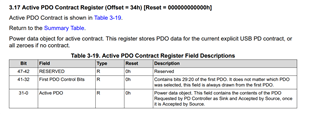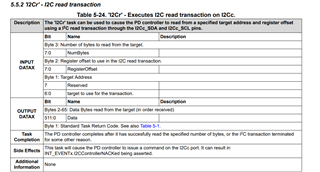Other Parts Discussed in Thread: BQ25731,
Tool/software:
I am using a TPS25751S with a BQ25731 charger chip. I cannot find anything in the USBCPD to add more configuration to the BQ chip other than charge current and charge voltage. I would like to add more configuration data to be sent to the BQ (the EEPROM must already contain info to be sent to the BQ2731 since charge current and charge voltage data is stored on the EEPROM and written to the BQ from TPS on bootup). What I am currently in need of is configuring the current sensing resistors for the BQ. I believe that the default is 5mOhm but I have 10mOhm which is supported, but needs to be configured on the BQ chip via I2C. There is likely more that I will want to configure on the chip on boot up as well. I do know that I can use I2C subcommands from my MCU through the TPS25751 to do this, but this seems slow and inefficient (datasheet says 5 seconds per command) and that would be frustratingly slow on boot up for a hardware configuration that won't change. Other commands I can see wanting are setting up ADCs I would want on the BQ to be available through subcommands of the TPS25751. Please let me know if there is a way to manipulate the binary for the EEPROM directly, or another USBCPD application tool that has more advanced features to add initialization I2C commands to the EEPROM that will be sent to the BQ25731 chip. Thanks.





